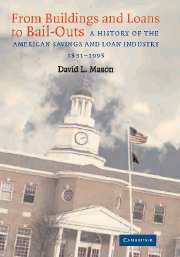 From Buildings and Loans to Bail-Outs
From Buildings and Loans to Bail-Outs Book contents
- Frontmatter
- Contents
- List of Tables
- Acknowledgments
- Introduction
- 1 A Movement Takes Shape, 1831–1899
- 2 The Rise of the League, 1900–1929
- 3 From State to Federal Oversight
- 4 The Movement Becomes an Industry, 1930–1945
- 5 The Glory Years, 1946–1955
- 6 External Challenges and Internal Divisions, 1956–1966
- 7 Lost Opportunities, 1967–1979
- 8 Deregulation and Disaster, 1979–1988
- 9 Resolving the Crisis, Restoring the Confidence, 1989–1995
- 10 The American Savings and Loan Industry in Perspective
- Appendices
- Fraud, Forbearance, and Failure: The Case of Empire Savings and Loan Association
- Success the Old Fashioned Way: The Case of Medford Cooperative Bank
- Bibliography
- Index
Success the Old Fashioned Way: The Case of Medford Cooperative Bank
Published online by Cambridge University Press: 29 October 2009
- Frontmatter
- Contents
- List of Tables
- Acknowledgments
- Introduction
- 1 A Movement Takes Shape, 1831–1899
- 2 The Rise of the League, 1900–1929
- 3 From State to Federal Oversight
- 4 The Movement Becomes an Industry, 1930–1945
- 5 The Glory Years, 1946–1955
- 6 External Challenges and Internal Divisions, 1956–1966
- 7 Lost Opportunities, 1967–1979
- 8 Deregulation and Disaster, 1979–1988
- 9 Resolving the Crisis, Restoring the Confidence, 1989–1995
- 10 The American Savings and Loan Industry in Perspective
- Appendices
- Fraud, Forbearance, and Failure: The Case of Empire Savings and Loan Association
- Success the Old Fashioned Way: The Case of Medford Cooperative Bank
- Bibliography
- Index
Summary
In contrast to the case study of Empire Savings and Loan Association of Mesquite, Texas, an analysis of Medford Co-operative Bank (MCB) provides an instructive example of how many thrifts survived the era of deregulation. MCB, like hundreds of savings and loans, began business in the late nineteenth century with the mission of helping people of modest means save for the future and become homeowners. Located in a suburb of a large urban center, this small association grew steadily, and over time developed a conservative business style that made it appear stodgy and resistant to change. While such characteristics were positive attributes that benefited MCB through the 1960s, by the 1970s some within the thrift saw them as liabilities.
Nonetheless, MC Bdealt remarkably well with the challenges of the 1980s. The main reason why it thrived when others failed is that management found ways to incorporate change while at the same time adhering to their traditional focus of serving the local community. This practice of “sticking to the knitting” meant that MCB's management was conservative but open to innovation, provided such changes complemented existing business lines and enhanced customer service. Furthermore, when it did enter into new business areas, the thrift did so cautiously, which gave it the opportunity to evaluate the results. In the 1990s, MCB made a number of significant changes, including conversion to a stock association and expansion into commercial lending, but the outlook of its leaders did not change.
- Type
- Chapter
- Information
- From Buildings and Loans to Bail-OutsA History of the American Savings and Loan Industry, 1831–1995, pp. 297 - 318Publisher: Cambridge University PressPrint publication year: 2004


